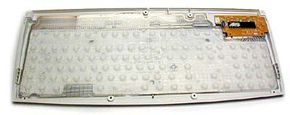Keyboard Switches
Keyboards use a variety of switch technologies. Capacitive switches are considered to be non-mechanical because they do not physically complete a circuit like most other keyboard technologies. Instead, current constantly flows through all parts of the key matrix. Each key is spring-loaded and has a tiny plate attached to the bottom of it. When you press a key, it moves this plate closer to the plate below it. As the two plates move closer together, the amount of current flowing through the matrix changes. The processor detects the change and interprets it as a key press for that location. Capacitive switch keyboards are expensive, but they have a longer life than any other keyboard. Also, they do not have problems with bounce since the two surfaces never come into actual contact.
All of the other types of switches used in keyboards are mechanical in nature. Each provides a different level of audible and tactile response -- the sounds and sensations that typing creates. Mechanical key switches include:
Advertisement
- Rubber dome
- Membrane
- Metal contact
- Foam element

Rubber dome switches are very common. They use small, flexible rubber domes, each with a hard carbon center. When you press a key, a plunger on the bottom of the key pushes down against the dome, and the carbon center presses against a hard, flat surface beneath the key matrix. As long as the key is held, the carbon center completes the circuit. When the key is released, the rubber dome springs back to its original shape, forcing the key back up to its at-rest position. Rubber dome switch keyboards are inexpensive, have pretty good tactile response and are fairly resistant to spills and corrosion because of the rubber layer covering the key matrix.
Rather than having a switch for each key, membrane keyboards use a continuous membrane that stretches from one end to another. A pattern printed in the membrane completes the circuit when you press a key. Some membrane keyboards use a flat surface printed with representations of each key rather than keycaps. Membrane keyboards don't have good tactile response, and without additional mechanical components they don't make the clicking sound that some people like to hear when they're typing. However, they're generally inexpensive to make.
Metal contact and foam element keyboards are increasingly less common. Metal contact switches simply have a spring-loaded key with a strip of metal on the bottom of the plunger. When the key is pressed, the metal strip connects the two parts of the circuit. The foam element switch is basically the same design but with a small piece of spongy foam between the bottom of the plunger and the metal strip, providing a better tactile response. Both technologies have good tactile response, make satisfyingly audible "clicks," and are inexpensive to produce. The problem is that the contacts tend to wear out or corrode faster than on keyboards that use other technologies. Also, there is no barrier that prevents dust or liquids from coming in direct contact with the circuitry of the key matrix.
Different manufacturers have used these standard technologies, and a few others, to create a wide range of non-traditional keyboards. We'll take a look at some of these non-traditional keyboards in the next section.
